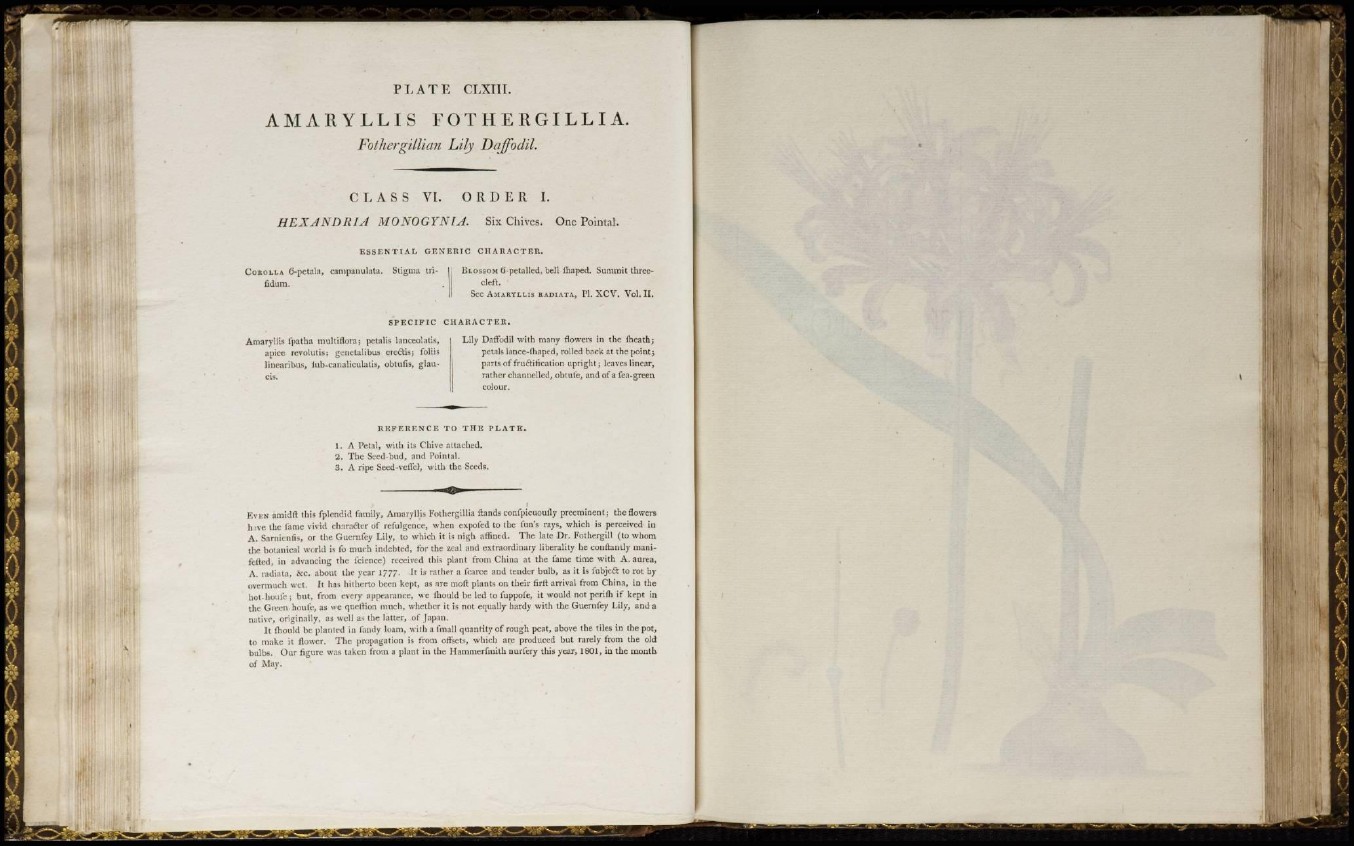
P L A T E CLXIII.
A M A R Y L L I S F O T H E R G I L L I A.
Fothergillian Lily Daffodil.
C L A S S VI. O R D E R I.
HEXANDRIA M 0 NO G YNI A. Six Chives. One Pointai.
E S S E N T I A L G E N E R I C C H A R A C T E R.
C O R O L L A G-petala, campanulata. Stigma trifidnm,
B L O S S O M G-petalled, bell fhaped. Summit threecleft.
See A M A R Y L L I S R A D I A T A , PI. X C V . Vol. II.
S P E C I F I C C H A R A C T E R.
A m a r y l l i s fpatha multiflorn; petalis lanceolatis,
ápice revolutis; genetalibus erectis; fours
l i n e a r i b u s , l u b - c a n a l i c u l a t i s , obtufis, glau-
Lily Daffodil with many flowers in the fheath;
petals lance-lhaped, rolled back at the p o i n t;
p a r t s of fruftification u p r i g h t ; leaves linear,
r a t h e r channelled, o b t u i e , and of a l e a - g r e en
colour.
R E F E R E N C E T O T H E P L A T E .
1 . A Petal, with its Chive a t t a c h e d.
2. T h e Seed b u d , and Po'mtal.
3 . A ripe Seed-veflel, with the Seeds.
E V E N amid ft this fplendid family, Amaryllis Fothergillia Hands confpicuoufly p r e e m i n e n t ; the flowers
b ve the lame vivid character of refulgence, when expol'ed t o t h e fun's rays, which is perceived in
A . Sarnienfis, or t h e Guernfey Lily, t o which it is n i g h a flint d . The l a t e D r . Fothergill (to w h om
t h e botanical world is fo much indebted, for the zeal and e x t r a o r d i n a r y liberality he conftantly inanifelied,
in advancing the fcience) received this plant from China at t h e fame time w i t h A. aurea,
A. r a d i a t a , &c. about the year \~TJ. It is r a t h e r a fcarce and tender b u l b , as it is fubject to rot by
overmuch wet. It has h i t h e r t o been kept, as a r e molt p l a n t s o n t h e i r firit arrival from China, in t he
hot-hotife ; but, from every a p p e a r a n c e , we ihould be led to fuppofe, it would not p e r i t h if kept in
t h e G i e e i i h o u i c , as we quelliou much, w h e t h e r it is not equally hardy w i t h the Guernfey Lily, and a
n a t i v e , originally, as well as t h e l a t t e r , of Japan.
It lbould be planted in fandy loam, with a fmall q u a n t i t y of rough peat, above the tiles in the p o t,
t o m a k e it flower. H i e propagation is from offset*, which are produced b u t rarely from the old
b u l b s . Our figure was t a k e n from a plant in the H a m m e r l ' m i l h nurt'ery this year, 1801, in the m o n th
of May.